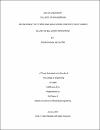DEVELOPMENT OF HYBRID AND NON-HYBRID COMPOSITE BODY ARMOR PLATE FOR BALLISTIC PROTECTION
| Advisor | Saad, Elsadig Mahdi |
| Author | Alkhatib, Farah Samih |
| Available date | 2017-03-06T10:46:02Z |
| Publication Date | 2017-01 |
| Abstract | In this work, a new Bullet Guiding Pocket Armor Plate (BGPAP) was developed, with a target to maximize the ballistic protection by containing the bullet between the layers. To this end, experimental and numerical programs have been carried out. Accordingly, the study has been divided into three phases concerning the problem solution to improve the energy absorption capability of the body armor plate without complete penetration. In phase-I, the effects of material stacking sequence and geometrical configuration on the ballistic behavior of hybrid and non-hybrid body armor plates were studied. Three different materials have been used, carbon fiber, Kevlar and date palm fiber. In phase-II, the effect of conical angles on the quasi-static crushing behavior of bullet guiding pockets was studied, in which five conical angles were tested, ranged between 35° and 55° with an increment of 5°. Two filament materials have been employed to fabricate the specimens. These are carbon fiber and Kevlar. The findings of the preceding phases were used as input for phase III, in which the new Bullet Guiding Pocket Armor Plate (BGPAP) has been developed. Finite Element software package, namely ANSYS/LS-DYNA has been used to simulate the ballistic behavior of tested body armors. Material stacking sequence has affected significantly the energy dissipation mechanism, energy absorption capability of hybrid composite body armor. Body armor with [CFRP10/KFRP30] material sequence displayed the highest energy absorption capability and passed the ballistic real shooting test. On the other hand, body armors with [CFRP4/KFRP6]4 had displayed poor energy dissipation mechanism and didn’t pass the ballistic real shooting. Incorporating the untreated date palm natural fiber composites in the material sequence of body armor displayed promising ballistic behavior, although didn’t pass all the three-trial real shooting test. Introducing bullet guiding pockets in the design of body armors has a significantly effect on their sliding crush behavior. Similar sliding crush behavior trends have been observed for both CFRP and KFRP bullet guiding pockets have been found similar. Designing the bullet guiding pockets within the CFRP layers displayed the highest energy absorption capability compared with KFRP layers. Bullet guiding pocket conical angles has been optimized, and specimens with 50° had the highest specific energy absorption capability in both CFRP and KFRP. The newly developed BGPAP showed an excellent ballistic performance against 9 mm bullet with BFS 19.6 mm. The newly developed BGPAP showed 16% reduction in weight compared to the hybrid [CFRP10/KFRP30] armor plate. |
| Sponsor | Qatar National Research Fund (a member of Qatar Foundation) through the National Priorities Research Program NPRP # 6-292- 2-127. |
| Language | en |
| Subject | body armor bulletproof composite material energy absorption finite element modelling hybrid material Mechanical engineering |
| Type | Master Thesis |
| Department | Mechanical Engineering |
Files in this item
This item appears in the following Collection(s)
-
Mechanical Engineering [67 items ]


